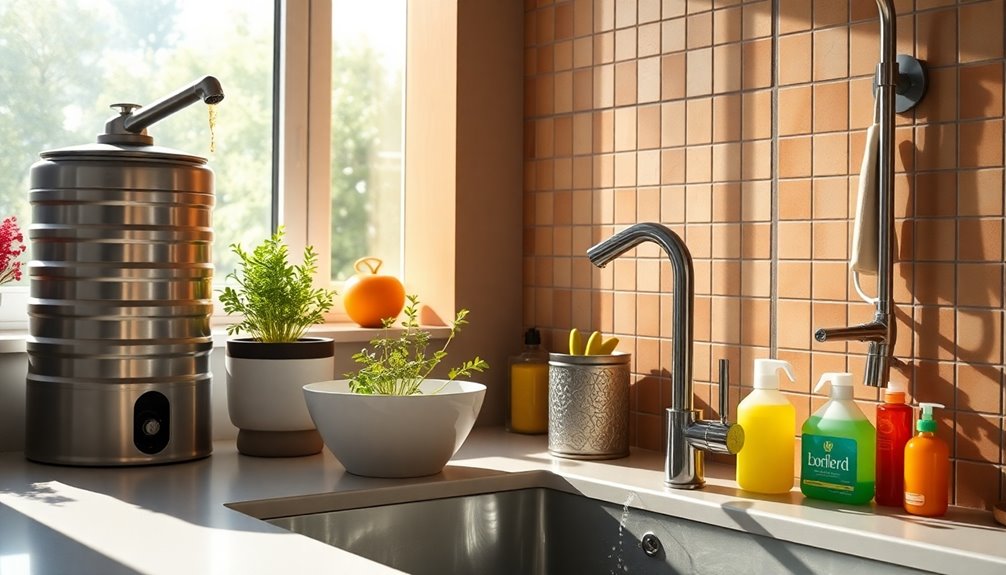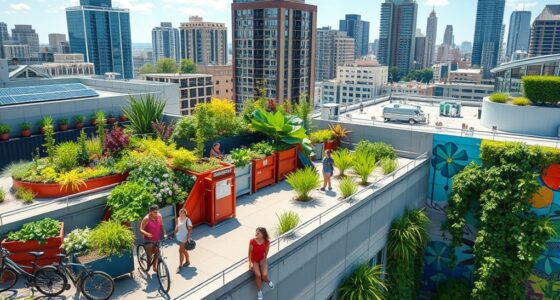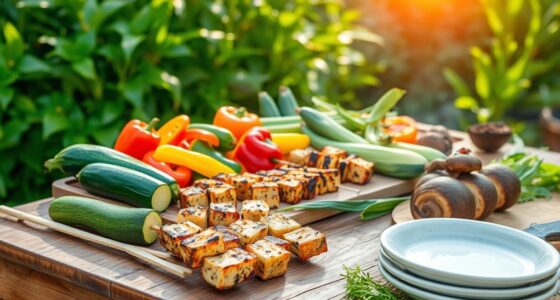To conserve water at home, start by fixing leaks, which can waste thousands of gallons annually. Upgrade to water-efficient appliances and install low-flow showerheads. Use smart irrigation techniques in your garden, like drip systems, to minimize evaporation. Consider xeriscaping for a low-water landscape design and collect greywater for reuse. Simple behavioral changes, like turning off taps while brushing teeth, also help. These techniques contribute to a sustainable future, and there's more to discover on effective water-saving methods.
Key Takeaways
- Fix leaks promptly by checking faucets, toilets, and pipes to save over 10,000 gallons of water annually.
- Upgrade to water-efficient appliances and fixtures, such as low-flow showerheads and dual-flush toilets, to reduce water usage.
- Implement smart irrigation systems that adjust watering based on weather and soil moisture conditions for efficient landscaping.
- Recycle greywater from sinks and showers for irrigation or toilet flushing to conserve fresh water resources.
- Practice simple habits like turning off the tap while brushing teeth to make a significant impact on water conservation.
Understanding the Importance of Water Conservation
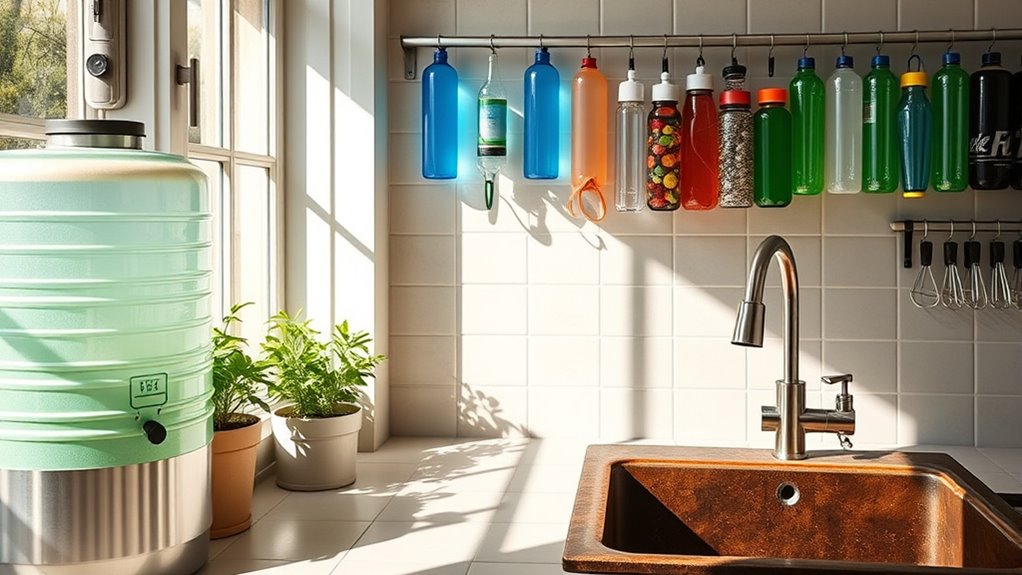
Water conservation is essential for sustaining our planet's resources and ensuring a healthy future. You mightn't realize how much water you use daily, but every drop counts.
By understanding the importance of conserving water, you can make a positive impact on your community and the environment. It helps preserve ecosystems, reduces energy consumption, and decreases water bills.
Understanding water conservation empowers you to positively impact your community, preserve ecosystems, and lower energy costs.
Moreover, with growing populations and climate change, fresh water is becoming scarcer. When you adopt water-saving habits, you contribute to a sustainable future for generations to come.
Simple actions, like turning off the tap while brushing your teeth or using a broom instead of a hose to clean driveways, can lead to significant savings. Every effort you make adds up!
Identifying and Fixing Leaks
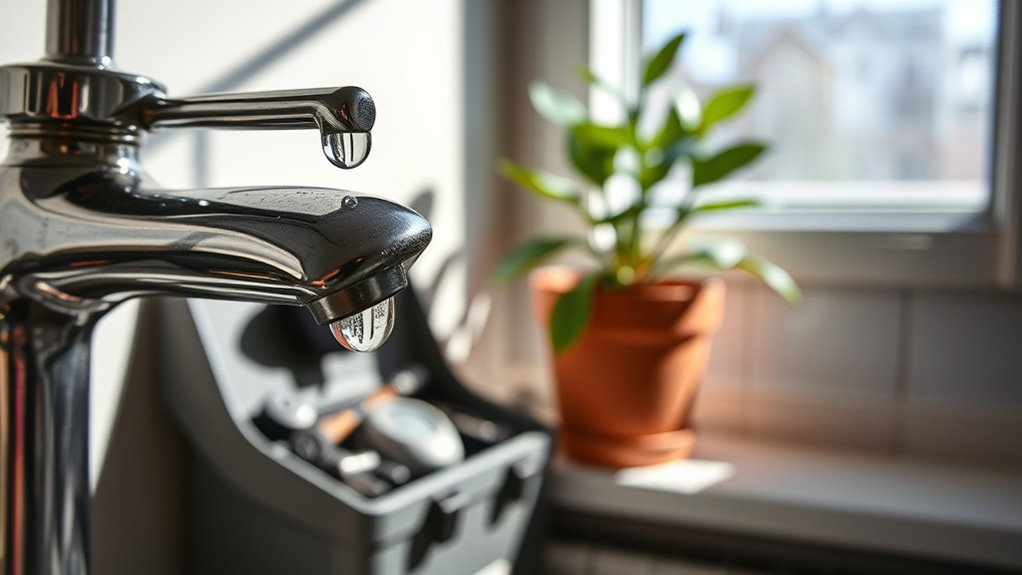
One small leak can waste more than 10,000 gallons of water each year, so it's crucial to identify and fix them promptly.
Start by checking your faucets, toilets, and pipes for signs of dripping or moisture. A simple way to test your toilet is by adding a few drops of food coloring to the tank; if the color appears in the bowl within 30 minutes, you've got a leak.
Don't forget to inspect your garden hoses and outdoor spigots, too.
Once you find a leak, you can often fix it easily with some plumber's tape or a new washer. For more serious issues, consider calling a professional.
Addressing leaks not only conserves water but saves you money on your water bill.
Water-Efficient Appliances and Fixtures

Fixing leaks is just the first step in a broader strategy for conserving water at home.
Next, consider upgrading to water-efficient appliances and fixtures. Look for Energy Star-rated dishwashers and washing machines, as they use significantly less water than older models. Low-flow showerheads and faucets can reduce water usage without sacrificing performance.
Installing dual-flush toilets allows you to choose the appropriate flush, saving water with every use. Also, consider using aerators on your faucets to maintain pressure while reducing flow.
By making these upgrades, you won't just save water; you'll also lower your utility bills. Investing in modern, water-efficient products is a smart choice for both your home and the environment.
Start implementing these changes today!
Smart Irrigation Techniques for Landscaping
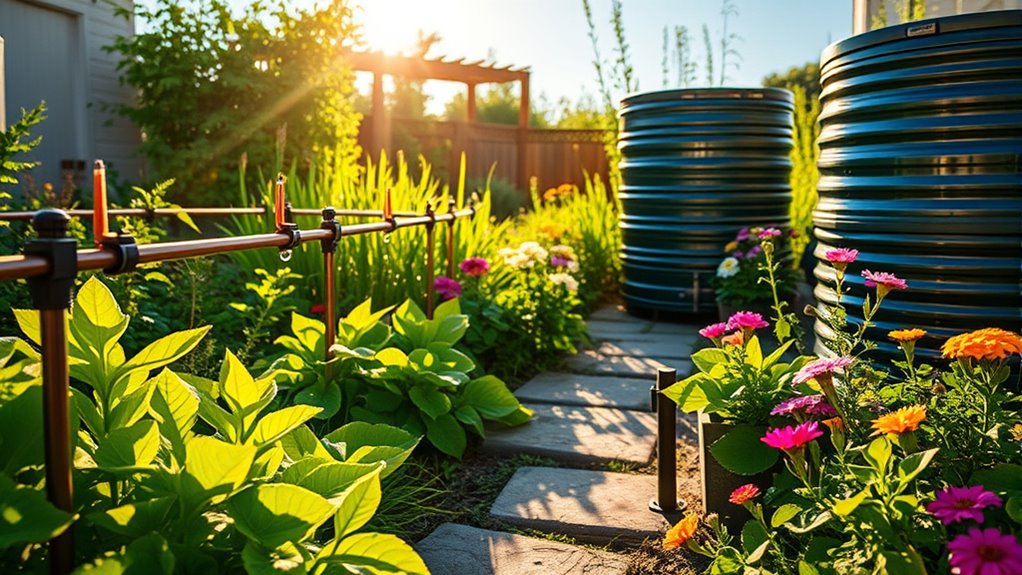
Efficient landscaping can significantly enhance your home's appeal while conserving water. One effective method is to install a smart irrigation system that adjusts watering schedules based on weather conditions.
These systems use sensors to monitor soil moisture and only water when necessary, preventing overwatering. You can also incorporate drip irrigation, which delivers water directly to plant roots, minimizing evaporation and runoff.
Grouping plants with similar water needs together will make your irrigation more efficient. Additionally, consider using mulch to retain soil moisture and reduce the need for frequent watering.
Rainwater Harvesting Systems
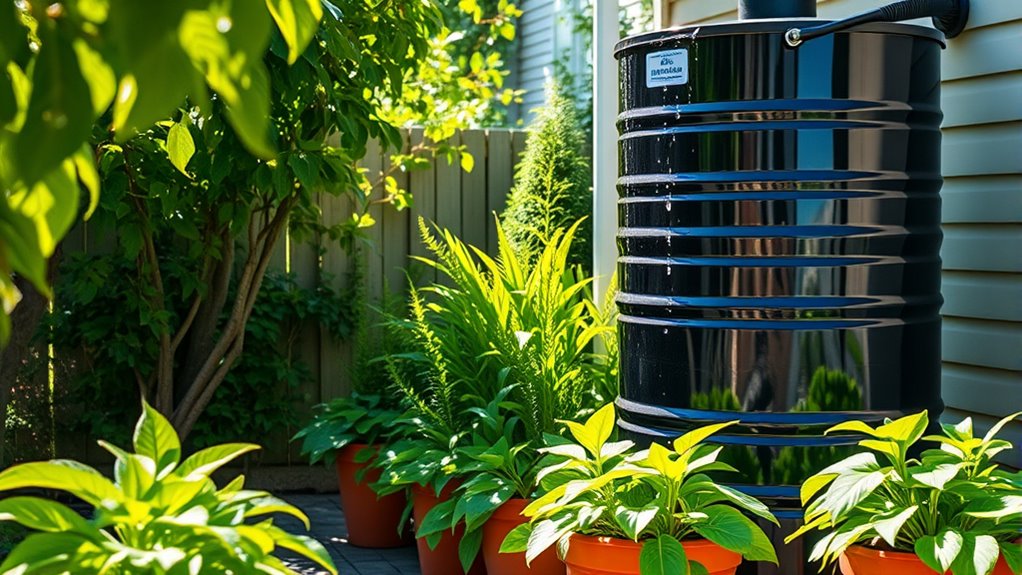
Although many homeowners overlook it, implementing a rainwater harvesting system can greatly enhance your water conservation efforts. By collecting rainwater from your roof, you can store it for various uses, such as watering plants or flushing toilets.
Start by installing a rain barrel connected to your downspouts. Make sure it has a lid to prevent mosquito breeding and debris contamination. You can also consider a more elaborate system with larger tanks and filtration for irrigation.
Regularly check and maintain your system to ensure it's functioning properly. Not only will this reduce your water bills, but it'll also lessen the demand on municipal water supplies.
With a little investment and effort, you can make a significant impact on your home's water usage.
Xeriscaping: Designing a Water-Saving Garden
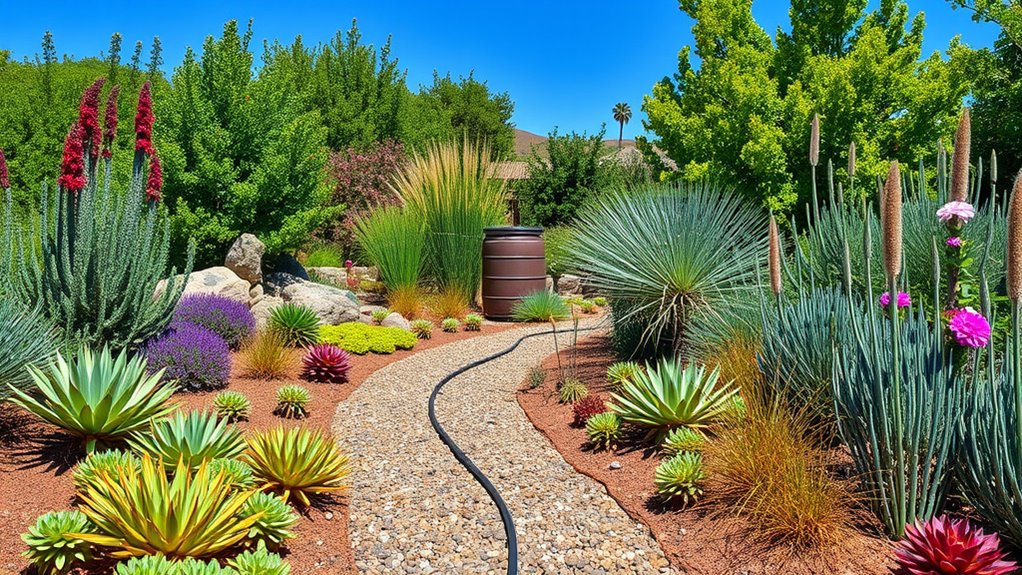
When you embrace xeriscaping, you're not just designing a garden; you're creating a sustainable landscape that thrives on minimal water.
Start by selecting drought-resistant plants suited to your climate, such as succulents, native grasses, and perennials. Group plants with similar water needs to simplify irrigation. Use mulch to retain soil moisture and reduce evaporation.
Optimize your garden layout by planning for sunlight and shade, ensuring efficient plant placement. Incorporate hardscaping elements like stones and pathways to reduce lawn areas.
Remember, xeriscaping isn't about eliminating beauty; it's about creating a vibrant, low-maintenance garden that flourishes with less water.
With thoughtful design, you'll enjoy a stunning outdoor space that conserves water and supports local wildlife.
Greywater Recycling and Reuse
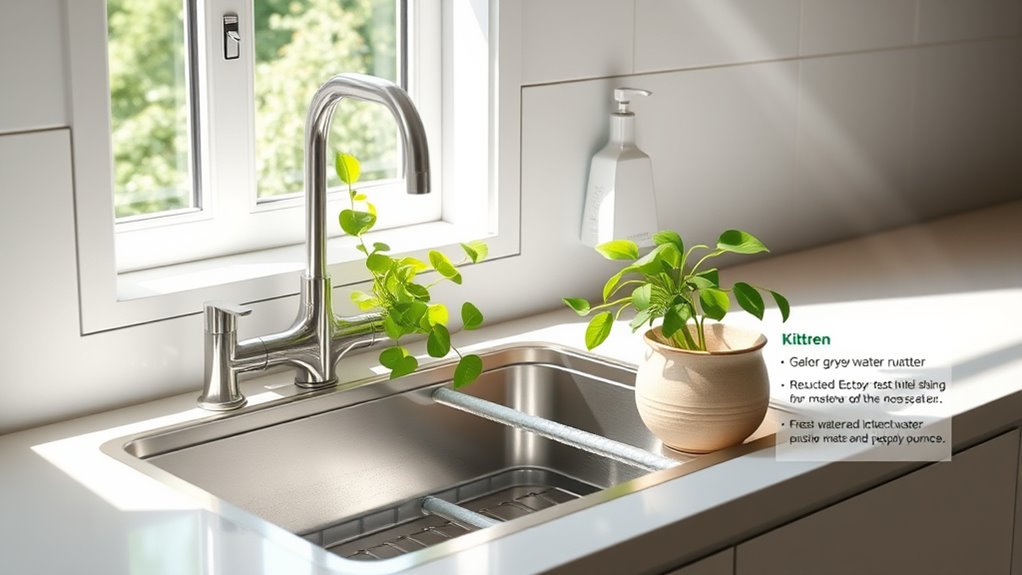
Greywater recycling and reuse can significantly reduce your water consumption while contributing to a more sustainable home. This process involves collecting wastewater from sinks, showers, and washing machines and repurposing it for irrigation or toilet flushing.
By implementing a greywater system, you not only save water but also decrease the strain on local water resources.
To get started, you can install a simple diverter to guide greywater to your garden or a storage tank. Be sure to use biodegradable soaps to keep your plants safe.
Regular maintenance is crucial; check for leaks and ensure your system functions properly. With a little effort, you'll enjoy a greener home and lower water bills while doing your part for the environment.
Behavioral Changes to Reduce Water Usage

Making small behavioral changes can have a big impact on reducing water usage in your daily life. Start by turning off the tap while brushing your teeth or shaving; this simple step can save gallons each time.
When it comes to showering, aim for shorter showers and consider installing a low-flow showerhead. Instead of rinsing dishes under running water, fill a basin or use the dishwasher for a more efficient clean.
You can also collect rainwater for outdoor use or water your garden in the early morning or late evening to minimize evaporation.
Lastly, check for leaks around your home and fix them promptly. These changes not only conserve water but also save you money on your utility bills.
Frequently Asked Questions
How Can I Track My Household Water Usage Effectively?
To track your household water usage effectively, start by checking your water meter regularly.
Record the readings weekly to spot any changes. You can also install a smart water monitor that provides real-time data on your usage.
Keep an eye on your water bill for monthly trends, and consider using a simple spreadsheet or app to log your daily consumption.
This way, you'll identify patterns and find areas to improve efficiency.
Are There Specific Plants That Require Less Water in My Garden?
Think of your garden as a thirsty traveler in the desert. You can choose drought-resistant plants that thrive on minimal water.
Consider succulents like agave or sedum, which store moisture, or native grasses that adapt well to local climates. Lavender and rosemary not only require less water but also add fragrance.
What Are the Financial Benefits of Water Conservation at Home?
When you conserve water at home, you're not just helping the environment; you're also saving money.
Lower water bills can boost your budget, allowing you to allocate funds elsewhere.
Additionally, investing in water-efficient appliances can lead to long-term savings by reducing energy costs associated with heating water.
Plus, many local governments offer rebates for implementing water-saving measures, providing you with even more financial incentives to make these changes.
How Do I Choose the Right Rain Barrel for My Needs?
Choosing the right rain barrel is like picking the perfect companion for a journey. You want one that fits your lifestyle and needs.
Start by considering your available space; a smaller barrel works well for tight spots, while larger ones suit bigger yards.
Look for durability and a secure lid to keep debris out. Don't forget to check the spigot height for easy access.
With the right barrel, you'll be ready to collect nature's bounty!
Can I Receive Rebates for Implementing Water-Saving Techniques?
Yes, you can often receive rebates for implementing water-saving techniques.
Many local governments and utility companies offer financial incentives to encourage conservation. To find out what's available, check your municipality's website or contact your water provider. They typically have information about qualifying products and programs.
Make sure to keep your receipts and any necessary documentation, as you'll need them to apply for the rebates and maximize your savings.
Conclusion
By embracing these water conservation techniques, you're not just saving a precious resource; you're nurturing a lush garden of sustainability in your home. Picture your faucet dripping less, your garden flourishing with smart irrigation, and rainwater collected like a treasure waiting to nourish your plants. Every small change you make is a drop in a shimmering ocean of environmental care. So let's turn the tide together—your simple actions can create waves of positive impact for generations to come.
